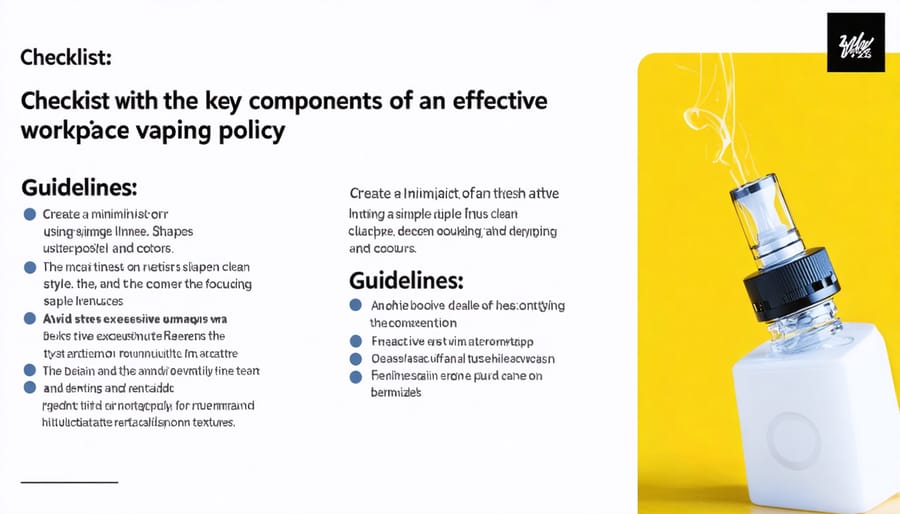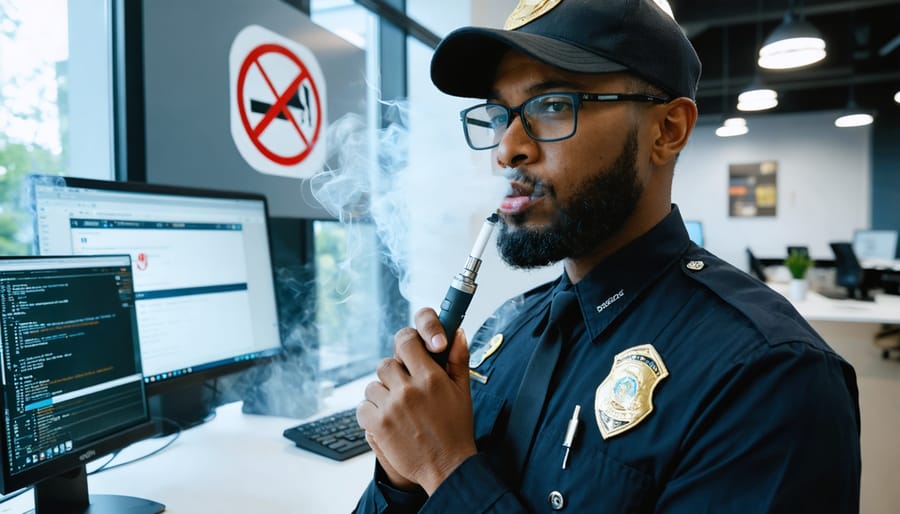As security organizations adapt to changing workplace dynamics, the rise of vaping presents unique challenges for policy development. While employees may choose to shop quality vapes during their personal time, organizations must establish clear guidelines that balance individual rights with professional responsibilities. This comprehensive guide explores how security leaders can develop and implement effective vaping policies that maintain workplace safety while respecting personnel choices.
Understanding Vaping in the Workplace
The Rise of Vaping
The rise of vaping has marked a significant shift in the landscape of tobacco use, with many viewing it as a preferable alternative to smoking traditional cigarettes. This shift is particularly relevant in security-related fields, where personnel often work in high-stress environments. Vaping, perceived as a less harmful option, offers flexible consumption methods and fewer lingering odors, making it appealing for those concerned about personal and professional interactions. However, as vaping has gained traction, it’s important to address potential security risks associated with this trend. Security personnel, tasked with maintaining safety and order, must balance these new habits with their responsibilities. Businesses and community leaders need to establish clear policies to guide the use of e-cigarettes in the workplace, ensuring they protect both employee rights and workplace security. Understanding this evolution helps tailor policies that respect individual choices while prioritizing safety and compliance within security services.
Vaping in Security Roles
Vaping among security personnel presents unique challenges and opportunities within the workplace. As vaping becomes more popular, it is critical for security companies to understand the vape pen risks and potential implications on duty. On one hand, allowing vaping can offer employees a stress-relief option, promoting a calm and focused demeanor, essential in security roles. However, it also involves monitoring usage to prevent distractions during critical tasks.
Case studies from various security firms have shown mixed impacts, highlighting the importance of structured policies that address when and where vaping is permissible. These policies should ensure vaping does not interfere with professional responsibilities or client safety. By consulting stakeholders, companies can develop balanced guidelines, reflecting both employee rights and operational needs. Transparent communication and training are key to enforcing these policies, ultimately maintaining trust and professionalism with clients and within the team.

Developing Effective Vaping Policies

Key Components of a Vaping Policy
Developing a robust vaping policy for security personnel necessitates a careful balance between maintaining workplace safety and respecting employee rights. A well-structured policy should clearly define where vaping is permitted or prohibited, ensuring that designated vaping areas are safe and comply with health standards. In addition, it’s important to consider the impact of vaping on others; therefore, policies should include measures to prevent exposure to second-hand vapor for non-vaping staff and clients.
The policy should also address the use of vaping devices during work hours. Guidance on whether employees can vape on duty and how it might affect their ability to perform tasks effectively is crucial. Furthermore, procedures for enforcement and the potential consequences of policy violations need to be explicit. This could include fines, disciplinary actions, or educational sessions aimed at promoting a better understanding of vaping etiquette within a security setting.
Training plays a vital role in the successful implementation of a vaping policy. Regular workshops or discussions can keep personnel informed about policy changes and health implications associated with vaping. Lastly, it’s beneficial to incorporate feedback mechanisms, allowing employees to voice concerns or suggestions, ensuring the policy evolves to meet both organizational and employee needs.
Balancing Safety and Human Resources
In today’s security landscape, implementing vaping policies for security personnel calls for a nuanced approach that balances critical safety protocols with employee rights. Establishing clear and fair guidelines is essential to maintain both the security of facilities and a healthy work environment. Security teams must rely on a framework that addresses both the communal need for safety and the individual’s right to personal choice.
One effective strategy involves input from various stakeholders, including security personnel, management, and health professionals. This collaborative approach ensures that policies are comprehensive and agreeable, minimizing resistance and enhancing compliance. For instance, setting designated vaping areas can reduce exposure to non-users while respecting personal freedoms. Conducting educational workshops can further clarify how these guidelines enhance overall safety without infringing on personal liberties.
Success stories from organizations that have implemented balanced vaping policies highlight practical outcomes and mutual benefits. A case study from SecureCo, a leading security service provider, noted improved employee morale and lesser conflicts when they established clear vaping boundaries and communication channels. Testimonials from SecureCo staff stressed the importance of feeling respected and heard during the policy development stages, which fostered trust and cooperation.
Ultimately, the balance between safety and human resources does not require compromise but instead fosters an environment where both can thrive in harmony. By ensuring transparency and empathy in the policy-making process, organizations can cultivate a safer, more respectful workplace.
Implementing and Enforcing Policies
Communication and Training
Effectively communicating vaping policies to security personnel requires a strategic approach focusing on clarity and engagement. Start by deploying a structured communication plan that outlines the new policies clearly, emphasizing their importance for both safety and professionalism. Utilize multiple channels such as emails, team meetings, and printed materials to ensure all staff members receive consistent information. Encourage open discussions in training sessions, where staff can voice concerns and gain a deeper understanding of the policies.
Training programs should be comprehensive yet straightforward, tailored to bridge knowledge gaps and address real-world scenarios. Incorporate industry-specific case studies to illustrate potential outcomes of policy compliance and violations. This approach not only boosts comprehension but also reassures employees that the policies are designed for their benefit. Including testimonials from security experts and satisfied clients can further validate the policies’ effectiveness. By fostering an environment of transparency and support, security personnel are more likely to embrace and comply with vaping regulations, enhancing the workplace’s overall safety and integrity.
Monitoring and Compliance
Monitoring adherence to vaping policies among security personnel requires a collaborative approach involving strategic planning, regular reporting, and support from human resources. Implementing technology-based solutions, such as surveillance cameras and access control systems, aids in overseeing compliance discreetly while respecting privacy. Regular audits and spot checks further ensure adherence without disrupting operations.
Dealing with non-compliance involves a structured escalation process. Initial violations should prompt a private discussion to understand the circumstances and provide re-education about policy expectations. Chronic non-compliance requires documented warnings and possibly disciplinary actions, emphasizing corrective over punitive measures.
Incorporating feedback from personnel during policy reviews can also enhance effectiveness and buy-in, creating a shared sense of responsibility. Homeowners, business owners, and community leaders can feel reassured knowing that security personnel operate within established guidelines, maintaining safety and professionalism. For individuals considering careers in security services, understanding these policies highlights the importance of integrity and accountability in the field.
Legal Considerations
Navigating the legal landscape surrounding vaping in the workplace is crucial for crafting effective policies for security personnel. It’s essential to understand both federal regulations and state-specific laws regarding vaping, as well as how they intersect with workplace rights and responsibilities. The Occupational Safety and Health Administration (OSHA) doesn’t specifically regulate vaping, leaving much of the responsibility to individual states and employers. Therefore, it’s vital for policy creators to be aware of any local legislation touching on vaping, including restrictions in enclosed workplaces or public areas, to ensure compliance.
Moreover, when developing vaping policies, it’s important to consider the rights of all employees, balancing the personal freedoms of those who vape with the health and comfort of non-vaping staff members. Clear guidelines help prevent potential legal disputes and misunderstandings, making it easier to enforce rules consistently. Consulting with legal experts can provide further clarity, ensuring that the policies not only comply with the laws but also respect employee rights and maintain workplace safety.
Open communication about these policies through regular briefings and updates can also foster a culture of respect and responsibility. By understanding legal considerations, businesses can create vaping policies that protect the company and its employees, ensuring a harmonious and compliant work environment.
Case Study: Successful Implementation
Montreal Security Services, a leading provider of comprehensive security solutions, set a benchmark by effectively integrating vaping policies tailored to the needs of their security personnel. Faced with challenges of ensuring workplace safety while respecting employee rights, the company embarked on a meticulous policy development journey. Through a collaborative approach that engaged stakeholders and employees, they crafted vaping guidelines that enhanced safety without compromising job satisfaction.
The company meticulously evaluated the settings where their security personnel operate, from high-rise offices to expansive events, to ensure their policy addressed various environmental needs. Open communication channels allowed security officers to voice concerns, fostering a culture of trust and cooperation. Alongside robust policy creation, targeted training sessions equipped personnel with a clear understanding of the new vaping guidelines, ensuring seamless adoption and compliance.
An internal compliance monitoring system was implemented, offering transparency and accountability. Feedback mechanisms were established, allowing continuous policy refinement and adaptation, which not only bolstered policy effectiveness but also increased employee morale. Montreal Security Services’ proactive approach resulted in a notable decrease in policy violations and an overall improvement in workplace safety and satisfaction. This case underscores the importance of thoughtful policy implementation in balancing workplace safety with the rights of employees.

Conclusion
In conclusion, the establishment and enforcement of vaping policies for security personnel are crucial for maintaining a professional and safe work environment. Such policies not only uphold workplace standards but also reflect a commitment to balancing employee rights with health and safety regulations. For homeowners, business owners, and community leaders, understanding these policies can enhance the selection process when hiring security services, ensuring that personnel upholds the values aligned with family-friendly or business-centric standards. Encouraging regular evaluation and adaptation of these policies is vital, as the landscape of vaping continues to evolve. Through ongoing assessment, organizations can ensure that their policies remain relevant and effective, catering to current health directives and technological advancements in vaping products. By doing so, security teams remain informed, compliant, and competent, underscoring their reliability and professionalism—traits that are indispensable in their line of work.
